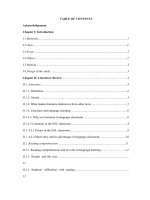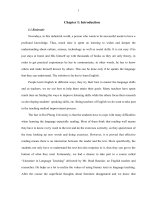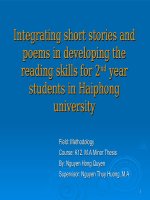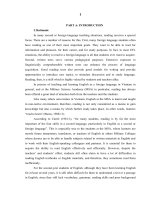Integrating short stories and poems in developing the reading skills for 2nd year students in haiphong university part 3
Bạn đang xem bản rút gọn của tài liệu. Xem và tải ngay bản đầy đủ của tài liệu tại đây (82.99 KB, 3 trang )
TABLE OF CONTENTS
Acknowledgement
Chapter I: Introduction
I.1.Rationale……………………………………………………………………….……………...1
I.2.Aims……………………………………………………………………………..……………..2
I.3.Scope ………………………………………………………………………….……………….2
I.4.Object…………………………………………………………………………..……………...2
I.5.Method…………………………………………………………………………..……….........3
I.6.Design of the study…………………………………………………………….……….........3
Chapter II: Literature Review ……………………………………………….……………...4
II.1. Literature…………………………………………………………………….………………4
II.1.1. Definition………………………………………………………………….………………4
II.1.2. Genres …………………………………………………………………….……………….5
II.1.3. What makes literature distinctive from other texts ………………….………………5
II.1.4. Literature and language teaching ……………………………………….……………..6
II.1.4.1. Why use literature in language classroom. ………………………….……………..6
II.1.4.2 Literature in the ESL classroom……………………….……………….……………..9
II.1. 4.2.1.Poetry in the ESL classroom………………………………………….…………....9
II.1. 4.2.2.Short story and its advantages in language classroom…………….…………..10
II.2. Reading comprehension …………………………………………………….…………..11
II.2.1. Reading comprehension and its roles in language learning………….……………11
II.2.2. Reader and the text……………………………...………………………………………11
II.2.3. Students’ difficulties with reading………………………….…………………………12
II.3. Literature and Reading……………………………..…………………………………….13
II.3.1. Some links between reading skills and literary skills……………..………………..13
II.3.2. Efferent reading and aesthetic reading……………………………….………………14
Chapter III: Methodology……………………………………………………………………15
III.1.The setting………………………………………………………………………………….16
III.2.The subjects………………………………………………………………..………………16
III.3.Data collection instruments………………………………………..…….………………17
Chapter IV: Results and Discussion……………………………………….………………19
IV.1. Students’ attitude towards literary texts……………………………….………………19
IV.2.The effects of short story and poem in teaching reading comprehension….………22
Chapter V. Conclusion and Recommendation…………………………………..………30
V.1.Introduction…………………………………………………………………………...…….30
V.2.Recommendation……………………………………………………………………..……30
V.2.1.Selecting and evaluating the texts………………………………………………..……30
V.2.2. Suggested techniques for integrating short stories and poems in the teaching of
reading comprehension skills…………………………………………………………..……31
V.2.2.1. Reading poems ………………………………………………………………….……31
V.2.2.2. Reading short stories……………………………………………………………..…..36
V.2.2.3. Overcoming cultural problems…………………………………………………..….39
V.2.3. Keys for using literary texts in reading classes………………………………….….41
V.3. Conclusion…………………………………………………………………………….…...43
V.4. Limitations of the study…………………………………………………………….……43
V.5. Suggestions for further research………………………………………………….……..44








